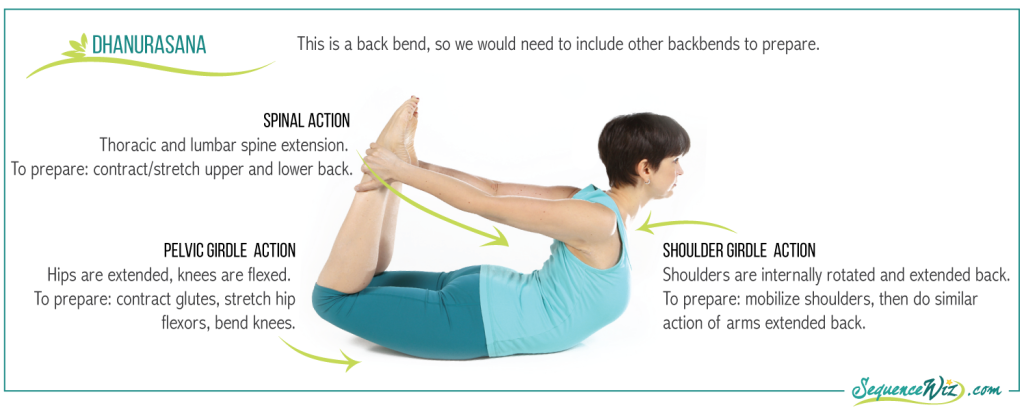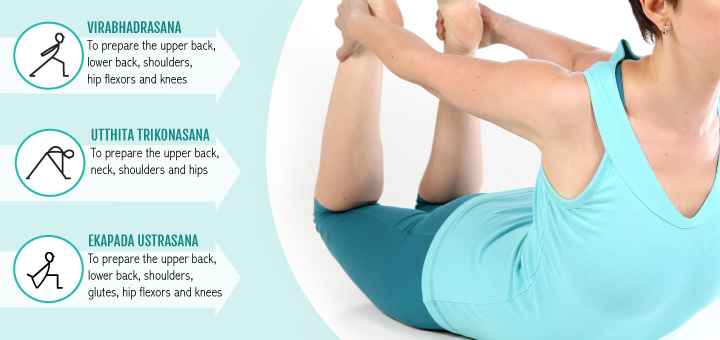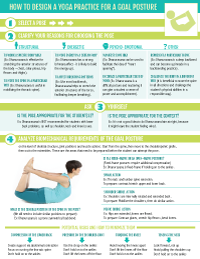A number of years ago a friend of mine went to a new yoga class.
At one point they did a Camel pose and my friend couldn’t quite reach
her heels. She was content keeping her hands on her back, until the yoga
teacher appeared beside her and began cheering “You are almost there –
reach, reach, reach!” My friend did reach her heels to the excited
clapping of the teacher and threw her back out. She was out of
commission for months.
At the risk of sounding like a broken record, I will say it again –
achieving the deepest form of the posture is NOT a goal in yoga. And
even though we do need to challenge ourselves physically and otherwise
to facilitate growth, we need to do so responsibly.
Many teachers seem to believe that the risks of a back bend are
minimized if the body is positioned properly in the posture. This is
certainly true, but this is not enough. Some other points that are
essential in making the back bends safer include:
- Building gradual progression of intensity (both in the space of one class and long-term)
- Limiting the number of back bends within one practice
- Using stabilizing postures
- Including adequate compensation
Let’s explore those.
1. Gradual progression means building the intensity
gradually toward the peak, where the following posture is a bit more
challenging then the one before it. If you have a certain pose in mind
that you would like to work toward, you would need to analyze the pose
first on the level of skeletal structure, joint positions and muscle
actions to see which parts of the body require preparation. We usually
start from the spine, then move to the shoulder/pelvic girdle, then out
to the extremities. For example:
 Then we can select some Core poses that would help us get there, for example:
Then we can select some Core poses that would help us get there, for example:

 Notice how the choice of the arm positions imitates the arm position
in the goal posture – this is also part of the preparation process. Of
course, we wouldn’t do those poses back-to-back; we would need to
compensate for them in the course of the practice.
2. Limiting the number of back bends. I’ve been to
yoga classes where the teacher seemed to include every back bend
possible. More is not better. For people who are already extra-bendy too
many back bends will only destabilize the structure, making it more
vulnerable. For those people who do not have a lot of spinal flexibility
it will be too much, since their bodies are not used to this sort of
movement – that’s an injury waiting to happen. Generally, I wouldn’t
recommend doing more then 4-5 back bends within a practice.
3. Stabilizing postures take care of the lower back
and sacrum. This is such an important role that back bends play, yet it
frequently goes overlooked. When we do all those fancy standing postures
– back bends, side bends, twists – we pull the spine and sacrum in
every direction while keeping the pelvis relatively stable. The
potential of torquing or destabilizing the SI joins
is high. So afterwards we need to stabilize the relationship between
the sacrum and pelvis by doing some sort of symmetrical prone back
bends; Vimanasana works great, as well as certain variations of
Bhujangasana.
Notice how the choice of the arm positions imitates the arm position
in the goal posture – this is also part of the preparation process. Of
course, we wouldn’t do those poses back-to-back; we would need to
compensate for them in the course of the practice.
2. Limiting the number of back bends. I’ve been to
yoga classes where the teacher seemed to include every back bend
possible. More is not better. For people who are already extra-bendy too
many back bends will only destabilize the structure, making it more
vulnerable. For those people who do not have a lot of spinal flexibility
it will be too much, since their bodies are not used to this sort of
movement – that’s an injury waiting to happen. Generally, I wouldn’t
recommend doing more then 4-5 back bends within a practice.
3. Stabilizing postures take care of the lower back
and sacrum. This is such an important role that back bends play, yet it
frequently goes overlooked. When we do all those fancy standing postures
– back bends, side bends, twists – we pull the spine and sacrum in
every direction while keeping the pelvis relatively stable. The
potential of torquing or destabilizing the SI joins
is high. So afterwards we need to stabilize the relationship between
the sacrum and pelvis by doing some sort of symmetrical prone back
bends; Vimanasana works great, as well as certain variations of
Bhujangasana.
 4. Adequate compensation is essential in bringing
the body back to the state of balance. We don’t bend back very often in
our daily lives, so for many people this is a foreign and intense
movement that needs to be neutralized. Often several poses are necessary
to compensate for a deep back bend. In the example of Dhanurasana we
might need couple of forward bends to stretch the back, an axial
extension posture to mobilize the hips and shoulders, and a twist to
realign the shoulder and pelvic girdles.
4. Adequate compensation is essential in bringing
the body back to the state of balance. We don’t bend back very often in
our daily lives, so for many people this is a foreign and intense
movement that needs to be neutralized. Often several poses are necessary
to compensate for a deep back bend. In the example of Dhanurasana we
might need couple of forward bends to stretch the back, an axial
extension posture to mobilize the hips and shoulders, and a twist to
realign the shoulder and pelvic girdles.
 Back bends play two very different distinctive roles in any yoga
sequence: some increase the range of motion of the spine and others
stabilize the lower back and sacrum. That’s why it matters how we
distribute them throughout the yoga practice. To see those ideas in
action, check out this step-by-step process of building a sequence for Dhanurasana.
Back bends play two very different distinctive roles in any yoga
sequence: some increase the range of motion of the spine and others
stabilize the lower back and sacrum. That’s why it matters how we
distribute them throughout the yoga practice. To see those ideas in
action, check out this step-by-step process of building a sequence for Dhanurasana.

 http://sequencewiz.org/2015/05/20/how-to-organize-back-bends-in-a-yoga-sequence/
http://sequencewiz.org/2015/05/20/how-to-organize-back-bends-in-a-yoga-sequence/
 Worrying has
become a national pastime. Whether you're worrying about repaying your
college loan, having job stability in an unstable economy or making sure
your toddler hits all the developmental milestones at the right times,
there's no shortage of material for mind sweat.
According to The Anxiety And Depression Association Of America,
anxiety disorders are the most common mental diagnosis in the United
States. They cost the country $42 billion a year, and go hand-in-hand
with depression. People with an anxiety disorder are also three to five
times more likely to go to the doctor and six times more likely to be
hospitalized for a psychiatric illness.
Especially for those of
us interested in wellness, it can almost feel tiring to be told the
importance of "letting go," "relaxing" and "unwinding." While this
advice is ultimately right, there's also good reason we might feel
inclined to resist it. The simple reason? Biology: all of our brains are
wired to worry.
Basically, the same brain circuits that make for
super human intelligence in our frontal lobes (allowing decision
making, problem solving, and planning) also produce worry. For your
brain, the only difference between worrying and planning is the amount
of emotional involvement and self-oriented processing in a specific part
of the brain. Of course, we all know worrying is charged with more
negative emotions.
But your brain's number one priority is keeping you alive, and it's evolved to do that very well. Sometimes, worrying is the body's response to danger, an evolutionary mechanism to keep you alive.
But
you can take concrete steps to climb out of the worry trap. You have to
learn to soothe and guide your thinking brain and calm it's fear
circuit. Here are some ways to begin:
1. Cultivate greater awareness about your emotions.
The first step to decreasing worry is to recognize when
you're doing it. Becoming aware of your emotional state as it occurs
enlists your thinking frontal cortex and suppresses the fight or flight
amygdala response. In the study Putting Feelings Into Words, when participants simply labeled an emotion, their brains calmed down.
2. Take a deep breath (ideally many of them).
Taking
slow, deep breaths through your nose into your diaphragm with slow
exhales turns down your nervous system and reduces your body's stress
response. This advice is undoubtedly not the most original, but that
doesn't mean it's not effective. Think of it this way: if your breathing
and heart rate naturally speed up when you are under stress, you can
choose to reverse your response — by breathing slowly. This will send
your body the message "I am relaxed," and you will become more relaxed
as a result. It's like magic, with science.
3. Don't look back or forward.
When
you find your mind drifting into the past or future, come back to the
present moment, right here right now — a practice known as mindfulness.
In this moment, you are OK. Your thoughts are creating your sense of
danger. Bringing your awareness back into the now calms the fearful
amygdala in your brain and activates your thinking neural circuits. Studies show that with repetition, mindfulness practice can lead to long term, lasting reduction of anxiety and worrying.
4. Pay attention only to what you can control.
Your
brain craves control and feels happier and calmer when it just feels
more in control — even if it's just an illusion. Feeling in control can
reduce anxiety, worrying, and even pain. So, avoid imagining the worst
possible scenarios, and instead pay more attention to what is in your
control, which modulates brain activity to reduce anxiety.
5. Make a decision, even if you don't really want to.
Simply
making a decision about whatever it is that you're worrying invokes
your thinking brain, increases dopamine levels, and shifts your brain's
perceptual focus on the things that matter the most. Making a decision —
any decision — also elevates your perceived control giving your
confidence and mood a boost which helps you to take positive action.
6. Go for good enough.
Worrying is often triggered by imposing unrealistic or perfectionist expectations
on yourself or others. Don't aim for being the perfect parent; just be a
good one. Your kid doesn't have to get into an Ivy League college. They
just need to go to college. You don't have to be model thin. You just
want to be healthy.
The problem with worry arises when the brain
anxiety-circuits activate too frequently and get stuck in the "on"
position continually which triggers the body's fear response. This then activates the stress response
— which starts a downward spiral ... making you a miserable mess. So
rather than make yourself more stressed out by worrying-about-worrying,
think of worry as your brain just doing its job. You just don't want it
to get too enthusiastic.
Photo Credit: Stocksy
Worrying has
become a national pastime. Whether you're worrying about repaying your
college loan, having job stability in an unstable economy or making sure
your toddler hits all the developmental milestones at the right times,
there's no shortage of material for mind sweat.
According to The Anxiety And Depression Association Of America,
anxiety disorders are the most common mental diagnosis in the United
States. They cost the country $42 billion a year, and go hand-in-hand
with depression. People with an anxiety disorder are also three to five
times more likely to go to the doctor and six times more likely to be
hospitalized for a psychiatric illness.
Especially for those of
us interested in wellness, it can almost feel tiring to be told the
importance of "letting go," "relaxing" and "unwinding." While this
advice is ultimately right, there's also good reason we might feel
inclined to resist it. The simple reason? Biology: all of our brains are
wired to worry.
Basically, the same brain circuits that make for
super human intelligence in our frontal lobes (allowing decision
making, problem solving, and planning) also produce worry. For your
brain, the only difference between worrying and planning is the amount
of emotional involvement and self-oriented processing in a specific part
of the brain. Of course, we all know worrying is charged with more
negative emotions.
But your brain's number one priority is keeping you alive, and it's evolved to do that very well. Sometimes, worrying is the body's response to danger, an evolutionary mechanism to keep you alive.
But
you can take concrete steps to climb out of the worry trap. You have to
learn to soothe and guide your thinking brain and calm it's fear
circuit. Here are some ways to begin:
1. Cultivate greater awareness about your emotions.
The first step to decreasing worry is to recognize when
you're doing it. Becoming aware of your emotional state as it occurs
enlists your thinking frontal cortex and suppresses the fight or flight
amygdala response. In the study Putting Feelings Into Words, when participants simply labeled an emotion, their brains calmed down.
2. Take a deep breath (ideally many of them).
Taking
slow, deep breaths through your nose into your diaphragm with slow
exhales turns down your nervous system and reduces your body's stress
response. This advice is undoubtedly not the most original, but that
doesn't mean it's not effective. Think of it this way: if your breathing
and heart rate naturally speed up when you are under stress, you can
choose to reverse your response — by breathing slowly. This will send
your body the message "I am relaxed," and you will become more relaxed
as a result. It's like magic, with science.
3. Don't look back or forward.
When
you find your mind drifting into the past or future, come back to the
present moment, right here right now — a practice known as mindfulness.
In this moment, you are OK. Your thoughts are creating your sense of
danger. Bringing your awareness back into the now calms the fearful
amygdala in your brain and activates your thinking neural circuits. Studies show that with repetition, mindfulness practice can lead to long term, lasting reduction of anxiety and worrying.
4. Pay attention only to what you can control.
Your
brain craves control and feels happier and calmer when it just feels
more in control — even if it's just an illusion. Feeling in control can
reduce anxiety, worrying, and even pain. So, avoid imagining the worst
possible scenarios, and instead pay more attention to what is in your
control, which modulates brain activity to reduce anxiety.
5. Make a decision, even if you don't really want to.
Simply
making a decision about whatever it is that you're worrying invokes
your thinking brain, increases dopamine levels, and shifts your brain's
perceptual focus on the things that matter the most. Making a decision —
any decision — also elevates your perceived control giving your
confidence and mood a boost which helps you to take positive action.
6. Go for good enough.
Worrying is often triggered by imposing unrealistic or perfectionist expectations
on yourself or others. Don't aim for being the perfect parent; just be a
good one. Your kid doesn't have to get into an Ivy League college. They
just need to go to college. You don't have to be model thin. You just
want to be healthy.
The problem with worry arises when the brain
anxiety-circuits activate too frequently and get stuck in the "on"
position continually which triggers the body's fear response. This then activates the stress response
— which starts a downward spiral ... making you a miserable mess. So
rather than make yourself more stressed out by worrying-about-worrying,
think of worry as your brain just doing its job. You just don't want it
to get too enthusiastic.
Photo Credit: Stocksy
 Then we can select some Core poses that would help us get there, for example:
Then we can select some Core poses that would help us get there, for example:





